Sonar Diving
Police Diving Pages - Main Page - Sign My Guestbook - Email Me
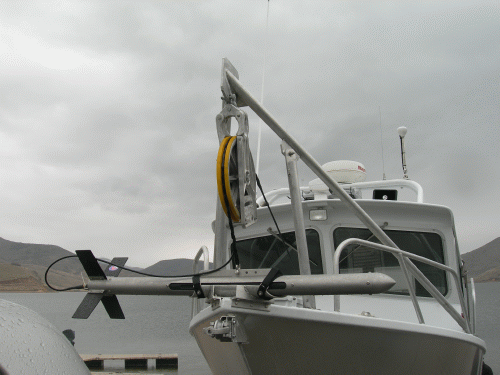

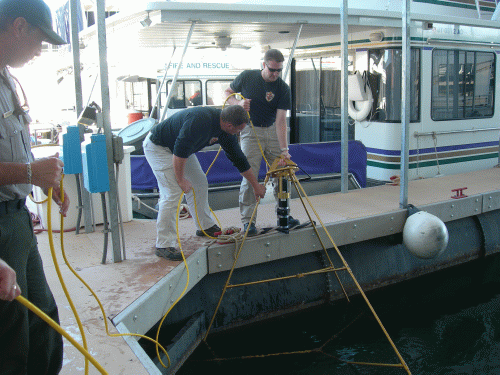



The Utah Department of Public Safety Dive Team was created as a Counter-Terrorism Unit. To facilitate this mission, two different types of underwater sonar technologies are used: Side-Scan Sonar and Sector-Scan Sonar.
A Side-Scan Sonar is a torpedo-shaped instrument which is towed beneath a boat at a certain depth just above the bottom. It emits sonar pulses but only side-ways from the sonar instrument or "fish." When a sonar pulse encounters an object, the rebounding sonar pulse is received by the fish's receiver asssembly and then interpolated by a computer program into a graphical image. The clarity of these image is such that it often easy to distinguish the shape of the object. When an object or "target" appears on the computer screen, a marker buoy is deployed to show the surface proximity of the target. The primary benefit of a Side-Scan Sonar is that large areas can be covered in relatively short periods of time. Video segments below will show the Side-Scan Sonar in action.
A Sector-Scan Sonar is an instrument which hangs from a tripod just off the bottom. The sonar "head" rotates in a similar fashion to a submarine sonar unit. The Sector-Scan unit works from a fixed location and can show incredible detail, as is seen in one of the photos below. The closer the sonar head is to the target, the clearer the image. Additionally, a Sector-Scan Sonar can be used to guide a diver(s) to a target, as some of the video segments below will show. Diver bubbles are very pronounced on the sonar screen and can be used as a reference to guide the divers.
The combination of deploying a Side-Scan Sonar along with a Sector-Scan Sonar is extremely efficient. The following photos and descriptions offer a degree of interesting reading. All photographs shown here are from training exercises.
| On 6 June 2010, a young man drowned at Huntington Reservoir, Utah. The DPS Dive Team deployed Side-Scan and Sector-Scan sonars to aid in the recovery. Divers were successfully guided via voice comms to the victim in the absolutely black water. |
|
| This is a video of two DPS Divers being guided by sonar to a target in 85' deep black water. The divers carried with them a line with which to secure the victim so the surface support personnel could then pull him up to the boat at the surface. The altitude of 6500' plus the depth of 85' prompted the Dive Master to choose this option, rather than have the Divers risk on-gassing a large volume of nitrogen by bagging the body at the bottom in zero-visibility water. The Divers come into view at the bottom of the anchor line and are then guided to the body via voice comms. This video is a good example of the possibilities afforded by using a Sector-Scan Sonar unit to guide divers in black water. Sonar-Guided Divers #1 | |
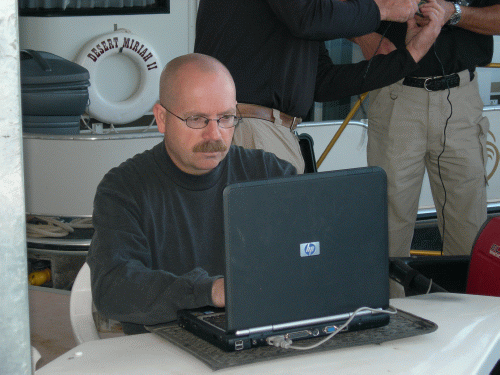 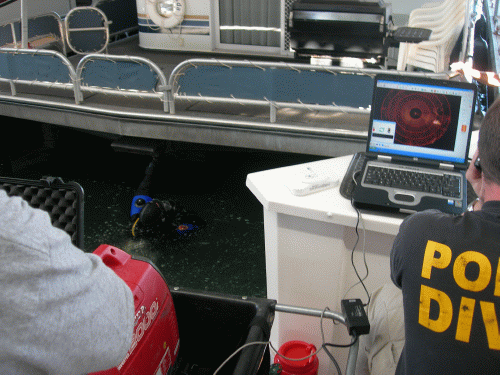 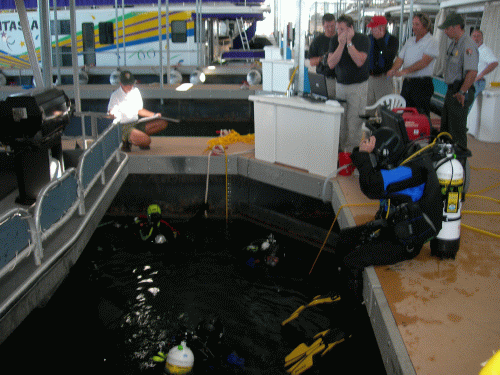 At left is an image of the computer screen on which a viable target may be seen above and to the left of the optical marker. This particular target is in 114' of black water, below a floating dock marina for houseboats which has numerous guy-wires crossing at unknown depths and angles. The optical marker was purposefully placed immediately next to the target so that the divers would not have to leave the marker and navigate to the target. This was one of the most technical and challenging dives I have participated in. |
|
| This photo represents the search area in Strawberry Reservoir in which we deployed Side Scan Sonar to locate the bodies of a husband & wife who drowned when waves capsized their aluminum fishing boat. The total size of the search area was 12.5 square miles. As the image shows, we ended up locating five bodies. Besides the two target victims, a victim of an incident five years earlier and two victims from eleven years earlier were located and recovered. This deployment was the cause of the DPS Dive Team being awarded the "Technical Fin Award" by the International Association of Dive Rescue Specialists (IADRS) for the most complex rescue/recovery of 2007. | |
| This is an actual photo of the computer screen impage when a drowning victim was located by Side Scan Sonar. If you look closely at the image, it is easy to discern that the victim is lying such that the head is at the bottom center of the image, then the torso is clearly seen, then as you look further upward the legs are seen, then finally at the top of the image the feet are clearly visible. This victim was indeed found to be lying on his back with his knees bent in just the fashion that the Side Scan Sonar image shows. In fact, when the body was found, the victim's left arm was positiones as if he were reaching to open a door-know. Now, look closely at the image and you can even visualize the left arm if you look closely. These subtle interpretations are highly desirable skills for a Side Scan Sonar operator, to be able to discern if the target is human or a log or a lawn-chair. This comes only with experience. |
  |
| HDMI Converter |